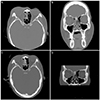Abstract
Purpose
Methods
Results
Conclusions
Figures and Tables
Figure 1
Clinical photographs of preoperative combined medial and inferior orbital wall fracture. (A) In near face view. (B) Worm's eye view, photographs of postoperative combined medial and inferior orbital wall fracture with Endoscopic transnasal and transconjunctival approach. (C) In near face view. (D) Worm's eye view.

Figure 2
Orbital Computed tomography of the patient. Orbital Computed tomography of preoperative combined medial and inferior orbital wall fracture. (A) Axial view. (B) Coronal view. Well-reconstructed medial and inferior orbital wall fracture with Endoscopic transnasal and transconjunctival approach. (C) Axial view. (D) Coronal view.

Table 1
Demographics of the surgical patients

Values are presented as mean ± SD unless otherwise indicated. Independent samples t-test was used to examine statistical difference.
Endoscopic with transconjunctival = endoscopic endonasal with transconjunctival reduction; Transcaruncular with transconjunctival = transcaruncular with transconjunctival reduction.
Table 2
Incidence of diplopia before and 6 months after repair

Values are presented as n (%) unless otherwise indicated. Chi-Square test and Fisher's Exact test was used to examine statistical difference.
Endoscopic with transconjunctival = endoscopic endonasal with transconjunctival reduction; Transcaruncular with transconjunctival = transcaruncular with transconjunctival reduction; Pre op = preoperative; Postop = postoperative.
Table 4
Hertel's exophthalmometer measure before and 6 months after surgical repair

Values are presented as mean ± SD unless otherwise indicated. Independent samples t-test was used to examine statistical difference.
Endoscopic = endoscopic endonasal reduction; Transcaruncular = transcaruncular reduction; Preop Exo = preoperative exophthalmometer measure; Postop 6 month Exo = postoperative 6 months exophthalmometer measure; Preop Exo diff = preoperative exophthalmometer measurement difference; Postop 6 month Exo diff = postoperative 6 months exophthalmometer measurement difference.




 PDF
PDF ePub
ePub Citation
Citation Print
Print



 XML Download
XML Download